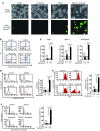67-kDa laminin receptor increases cGMP to induce cancer-selective apoptosis
- PMID: 23348740
- PMCID: PMC3561824
- DOI: 10.1172/JCI64768
67-kDa laminin receptor increases cGMP to induce cancer-selective apoptosis
Abstract
The 67-kDa laminin receptor (67LR) is a laminin-binding protein overexpressed in various types of cancer, including bile duct carcinoma, colorectal carcinoma, cervical cancer, and breast carcinoma. 67LR plays a vital role in growth and metastasis of tumor cells and resistance to chemotherapy. Here, we show that 67LR functions as a cancer-specific death receptor. In this cell death receptor pathway, cGMP initiated cancer-specific cell death by activating the PKCδ/acid sphingomyelinase (PKCδ/ASM) pathway. Furthermore, upregulation of cGMP was a rate-determining process of 67LR-dependent cell death induced by the green tea polyphenol (-)-epigallocatechin-3-O-gallate (EGCG), a natural ligand of 67LR. We found that phosphodiesterase 5 (PDE5), a negative regulator of cGMP, was abnormally expressed in multiple cancers and attenuated 67LR-mediated cell death. Vardenafil, a PDE5 inhibitor that is used to treat erectile dysfunction, significantly potentiated the EGCG-activated 67LR-dependent apoptosis without affecting normal cells and prolonged the survival time in a mouse xenograft model. These results suggest that PDE5 inhibitors could be used to elevate cGMP levels to induce 67LR-mediated, cancer-specific cell death.
Figures








Comment in
-
Cancer therapy combination: green tea and a phosphodiesterase 5 inhibitor?J Clin Invest. 2013 Feb;123(2):556-8. doi: 10.1172/JCI67589. Epub 2013 Jan 25. J Clin Invest. 2013. PMID: 23348734 Free PMC article.
Similar articles
-
Phosphodiesterase 5 inhibitor acts as a potent agent sensitizing acute myeloid leukemia cells to 67-kDa laminin receptor-dependent apoptosis.FEBS Lett. 2013 Sep 17;587(18):3052-7. doi: 10.1016/j.febslet.2013.07.041. Epub 2013 Aug 1. FEBS Lett. 2013. PMID: 23916810
-
Green tea polyphenol EGCG induces lipid-raft clustering and apoptotic cell death by activating protein kinase Cδ and acid sphingomyelinase through a 67 kDa laminin receptor in multiple myeloma cells.Biochem J. 2012 Apr 15;443(2):525-34. doi: 10.1042/BJ20111837. Biochem J. 2012. PMID: 22257159
-
Cancer cell selective probe by mimicking EGCG.Biochem Biophys Res Commun. 2020 May 14;525(4):974-981. doi: 10.1016/j.bbrc.2020.03.021. Epub 2020 Mar 12. Biochem Biophys Res Commun. 2020. PMID: 32173528
-
67-kDa Laminin Receptor-Mediated Cellular Sensing System of Green Tea Polyphenol EGCG and Functional Food Pairing.Molecules. 2022 Aug 11;27(16):5130. doi: 10.3390/molecules27165130. Molecules. 2022. PMID: 36014370 Free PMC article. Review.
-
Recent Advances in the Function of the 67 kDa Laminin Receptor and its Targeting for Personalized Therapy in Cancer.Curr Pharm Des. 2017;23(32):4745-4757. doi: 10.2174/1381612823666170710125332. Curr Pharm Des. 2017. PMID: 28699539 Review.
Cited by
-
Crosstalk between m6A mRNAs and m6A circRNAs and the time-specific biogenesis of m6A circRNAs after OGD/R in primary neurons.Epigenetics. 2023 Dec;18(1):2181575. doi: 10.1080/15592294.2023.2181575. Epigenetics. 2023. PMID: 36861189 Free PMC article.
-
Vitamin E functions by association with a novel binding site on the 67 kDa laminin receptor activating diacylglycerol kinase.J Nutr Biochem. 2022 Dec;110:109129. doi: 10.1016/j.jnutbio.2022.109129. Epub 2022 Aug 15. J Nutr Biochem. 2022. PMID: 35977663 Free PMC article.
-
Non-specific protein modifications may be novel mechanism underlying bioactive phytochemicals.J Clin Biochem Nutr. 2018 Mar;62(2):115-123. doi: 10.3164/jcbn.17-113. Epub 2018 Feb 7. J Clin Biochem Nutr. 2018. PMID: 29610550 Free PMC article. Review.
-
The combined effect of green tea and α-glucosyl hesperidin in preventing obesity: a randomized placebo-controlled clinical trial.Sci Rep. 2021 Sep 24;11(1):19067. doi: 10.1038/s41598-021-98612-6. Sci Rep. 2021. PMID: 34561541 Free PMC article. Clinical Trial.
-
FOXO3 is essential for CD44 expression in pancreatic cancer cells.Oncogene. 2017 May 11;36(19):2643-2654. doi: 10.1038/onc.2016.426. Epub 2016 Nov 28. Oncogene. 2017. PMID: 27893718
References
Publication types
MeSH terms
Substances
LinkOut - more resources
Full Text Sources
Other Literature Sources
Molecular Biology Databases

